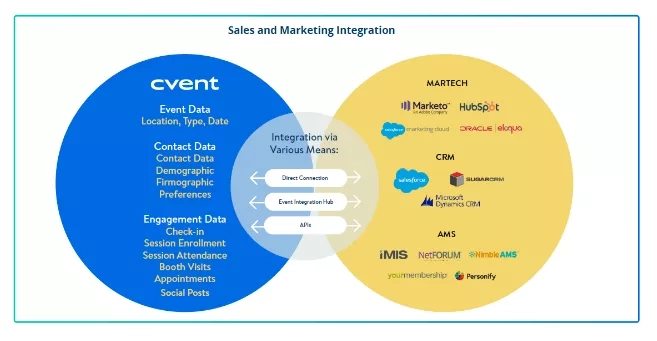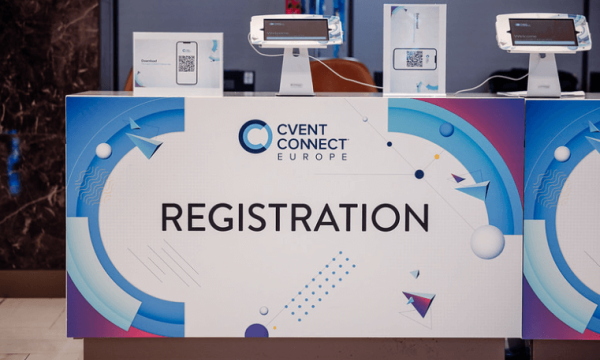Events have always been a powerful marketing channel. Why? Because they provide you with rich data and insights about your audience to help you stay competitive and grow your business. But making the most of the valuable data that comes from the events you host or attend requires event technology to capture the data, and the ability to integrate this with your other marketing systems.
Integrating your event technology with your marketing technology helps you squeeze every last drop of value from your audience insights and use them to enrich your full marketing strategy.
Let’s explore whyintegrating event tech is so important and look at some real-life examples of integration success.
Table of contents:
Why event technology completes your MarTech stack
Event technology complements other marketing systems by facilitating data integration, personalisation, marketing automation, and so much more. Put simply, it enables you to take your audience insights and feed this treasure trove into your other marketing channels (think email, social media etc.).
More accessible audience insights means better targeting in your multichannel marketing campaigns. And that means more leads and higher ROI.
Let’s take a closer look at the benefits for your team and organisation as a whole.
1. Get a full picture of data and audience profiles
You wouldn’t pass up on an opportunity to track key marketing metrics on other channels, so why not squeeze every bit of insight you can from your events?
Integrating event technology into your full marketing tech stack is a great way to gather comprehensive data about attendees' interactions, preferences, and engagement levels during events.
A holistic view is what you’re after. And you can get this by consolidating your data and audience profiles with technology like customer relationship management (CRM) platforms.
This insight allows for more effective segmentation, personalisation, and targeting in your marketing campaigns and leads to improved engagement and conversion rates.
2. Align sales and marketing efforts
Ah, that age-old challenge of maintaining a constant alignment with sales. While it’s not always easy, here’s the good news: event technology makes it easier forsales and marketing teams to communicate and share data.
By automatically syncing event-generated leads with CRM systems, both teams have access to the same up-to-date information about prospects. And this means better lead management and enhances collaboration between sales and marketing.
Plus, by integrating your event registration software with your CRM, your sales team can automatically send out invitations and gather registrations with minimal manual intervention.
3. Remove manual processes
Integrating event technology helps you automate many manual processes involved in event management, lead capture, and follow-up.
Automating tasks such as attendee registration, badge printing, lead qualification, and email communication, saves time and resources for your team.
This efficiency gives your team a way to focus on more strategic activities, such as crafting targeted marketing campaigns and nurturing leads, leading to increased productivity and better results.
4. Build a marketable database and augment your contacts
Event technology enables you to capture valuable audience and customer data and expand your contact database.
But taking this comprehensive database of leads and contacts and integrating it with your other MarTech makes the data easily accessible.
A larger marketable database, plus better contact profiles, gives you a wider audience to engage more opportunities to add new contacts to your marketable database.
5. Create targeted event follow-up and nurture campaigns
Integrating event technology with marketing systems gives you a way to create targeted follow-up and nurture campaigns.
Use this data to tailor follow-up communication to specific audience segments, and deliver relevant content and offers that drive engagement and conversions.
This targeted approach increases the effectiveness of your post-event marketing efforts and nurtures leads through the sales funnel more efficiently.
6. Accelerate sales pipeline
Want to accelerate your sales pipeline? Integrating event technology into your marketing tech helps you give your sales teams more qualified leads and better actionable insights.
Automated lead scoring and routing ensure that sales reps prioritise follow-up on high-value prospects, reducing lead response times and increasing conversion rates. This shortens the sales cycle and accelerates revenue generation from event-generated leads.
7. Prove the impact of your events through data
Measuring the impact of your events is a critical part of any marketing strategy. Integrating event technology into your existing MarTech enables you to measure events as you would any other channel. This gives you a more complete picture of your marketing strategy and investments.
You can use data to demonstrate the ROI of your events by tracking key performance metrics such as attendance, engagement, lead generation, and revenue attribution. This insight helps justify event investments, optimise future event strategies, and make data-driven decisions that drive business growth.
How to integrate your event tech with Salesforce
Salesforce is an integral CRM tool for both marketing and sales. So, why not make it even more valuable by feeding your event data into it? Integrating event technology with Salesforce offers several benefits, including:
Event registration and management: Allows seamless event registration, ticketing, and management within Salesforce, enabling organisers to track attendee information, session preferences, and ticket sales in real-time.
Lead capture and qualification: Gives you a way to capture leads directly from events into Salesforce, including attendee interactions, interests, and engagement levels, facilitating lead qualification and segmentation for targeted follow-up.
Data synchronisation: Ensures bidirectional synchronisation of data between event technology platforms and Salesforce, ensuring that attendee information, interactions, and engagement data are automatically updated and reflected in Salesforce records.
Integrating Cvent with Salesforce
The good news is that Cvent offers seamless integrations with Salesforce, enabling you to make use of all of the above features. Here are a few specific benefits Cvent’s Salesforce integration offers:
Increase event attendance and revenue: Enable your team to invite, nominate, and register prospects and customers for events – without having to log in to your Cvent account.
Get deeper insights into your contacts: Cvent’s Salesforce integration puts your valuable attendee data front and centre. By having it within easy reach on Salesforce, acting on it becomes more manageable for your marketing and sales teams.
Understand event impact and ROI: Reporting on the success of your events is vital. Cvent’s Salesforce integration gives you an easy way to report to your stakeholders on new leads, sales pipeline, and closed business coming from your events.
💡 Get started with Cvent’s Salesforce integration:
How to integrate your event tech with HubSpot
HubSpot, a leading marketing automation system and CRM, helps organisations attract, engage, and delight customers. Here’s what you can expect by integrating your event technology with HubSpot:
Streamlined event management: Integration allows for seamless event management by synchronising event data, registrations, and attendee information with HubSpot. This streamlines workflows and centralises event-related tasks within the HubSpot platform.
Improved lead generation: Send your event leads directly into HubSpot's CRM. This facilitates lead qualification, tracking, and nurturing. It also helps you generate high-quality leads from events and effectively manage them through the sales funnel.
Enhanced personalisation: Integration allows for personalised communication with event attendees using HubSpot's marketing automation capabilities. Segment attendees based on their interests, behaviours, and interactions, then target them with follow-up and nurturing campaigns.
Integrating Cvent with HubSpot
By integrating Cvent with HubSpot, you'll gain valuable insights to optimise your events, assess sales impact, craft targeted campaigns, and effectively monetise your events. Let’s explore the benefits of Cvent’s HubSpot integration:
Build richer, more in-depth prospect and customer profiles: Create comprehensive customer profiles that capture both online and offline interactions by combining event data with existing CRM data in HubSpot. The richer your data, the more successful you’ll be in segmenting prospects and customers based on their event participation, interests, and engagement levels.
Improve the effectiveness of cross-channel marketing: Leveraging insights from event participation, you can tailor marketing messages across multiple channels to resonate with specific audience segments. This targeted approach improves the relevance and effectiveness of your marketing efforts.
Provide a more personalised event experience: Remember those richer, more in-depth prospect and customer profiles? They help you provide a personalised event experience from pre-event engagement to the onsite experience, and post-event follow-up.
💡 Get started with Cvent’s HubSpot integration:
Real-life example: AMD integrates with Marketo, Tableau, and Salesforce
Let’s face it, integrating your event technology with your existing MarTech can seem daunting. So, let's look at how AMD integrated with Marketo, Tableau, and Salesforce to ensure a seamless dataflow across their event lifecycle.
“We were really able to capture some strong data, which is important because AMD has spent a lot of time and money in the last two years investing in our MarTech stack,” Katie Moon, Senior Manager of Corporate Events, explains.
These integrations enabled them to automatically sync contact lists and updates, which eliminated the need for manual labour and capacity for human error.
It also helped AMD track marketing engagement and overall campaign performance and enable better follow up by their sales and marketing teams. “Those integrations are really, I think, the key to the success in maximising your events portfolio and showing your stakeholders that what you’re doing is bringing actual opportunities to the table.”
Where are you in your integration journey?
When it comes to integrating your MarTech, different organisations will be at different stages. To help you benchmark where you are, let’s take a look at the three stages of integration maturity:
Foundational (one-way integration)
In the foundational stage of integration maturity, organisations typically implement basic one-way integrations between systems. This might mean that you’re syncing your attendee data with another system (like your CRM).
One-way integrations are often implemented using APIs (application programming interfaces) or middleware tools that facilitate data transfer between systems.
But while foundational integrations provide some level of automation and efficiency, they are limited in their ability to synchronise data and support more advanced use cases such as out of the box integrations.
Intermediate (bidirectional integration)
As organisations mature in their integration capabilities, they move towards intermediate (or bidirectional) integrations that enable two-way communication between systems. This allows for the exchange of data and information between systems in both directions, enabling real-time synchronisation and updates.
Bidirectional integrations are more complex to implement than one-way integrations. However, they offer greater flexibility and efficiency by ensuring data consistency across systems and supporting more sophisticated workflows and business processes.
Advanced (multiple systems integrated)
In the advanced stage of integration maturity, organisations integrate multiple systems across their technology stack to create a unified and interconnected ecosystem.
This involves integrating various systems and applications, such as CRM, marketing automation, e-commerce, analytics, and more. Advanced integrations enable seamless data flow and communication between different parts of your organisation, breaking down silos and improving cross-functional collaboration.
Advanced integrations often require custom development, extensive planning, and ongoing maintenance to ensure interoperability and data integrity. However, they also provide you with a comprehensive view of your operations, audience, and business performance, enabling you to make informed decisions.
Take your event marketing strategy to the next level with integrations
An event strategy that adds tremendous value to your marketing operations is the dream, isn’t it? Integrating event technology into your existing MarTech is a fantastic way to prove your events’ value to stakeholders, improve your overall marketing activities, and save time.
Learn more about how marketing teams use Cvent to drive ROI with integrations.








